What is GDPR compliance software?
GDPR software refers to solutions designed to assist organizations in achieving compliance with the General Data Protection Regulation (GDPR), a comprehensive data privacy law in the European Union.
GDPR compliance software typically offers features and tools to help businesses manage various aspects of GDPR compliance, including:
- consent management
- data protection impact assessments
- data subject access requests
- documentation and storage
- breach notifications
New Google consent requirements for companies in 2024
Google is now requiring that companies using its services implement one of two options:
- Integrate new consent mode parameters directly into Tag Manager to comply with key GDPR mandates.
- Use a Google-certified consent management platform for ad platform access. This is to ensure explicit user consent is obtained for the use of cookies/tracking and data processing for ad personalization as required by GDPR.
Advertisers who don't comply will be restricted from access to significant features, like personalization, when running ads in the EU, UK, and Switzerland.
Additionally, companies using Google's advertising and analytics products in the EU, EEA, UK, or Switzerland must implement the latest version of Google's Consent Mode from July 31, 2024, for Swiss traffic. Doing so sends verifiable consent signals to Google to enable continued conversion measurement and other functions if users don't consent to tracking cookies.
10 of the best GDPR compliance software
It can be challenging to choose the right GDPR solution for your company because there are so many options available. To make it simpler for you to choose the ideal fit for your organization, we have assembled ten options.
For each platform, we highlight features, key functions (both included and not included), pricing, and whether they offer a free trial or free version.
Cookiebot™
Cookiebot™ is an EU-based company that can enable you to automate your GDPR compliance for your website for cookie and tracker consent requirements. The software scans your website regularly to detect all the cookies and trackers in use, saving time for website owners. With the cookie declaration feature, data processing services automatically get added to your website’s privacy policy and can populate the consent banner for granular user notifications. All cookies are blocked until a user provides explicit consent for their use, adhering to the GDPR's strict consent requirements.
Cookiebot™ is also a Google-certified CMP that enables you to comply with Google’s requirements for third parties using its services and that collect personal data, like those for Consent Mode or the EU user consent policy.
Cookiebot™ integrates with Google Consent Mode, Google Tag Manager, and the TCF 2.2, as well as with the WordPress Consent API. There is also a free WordPress plugin for sites built on that platform.
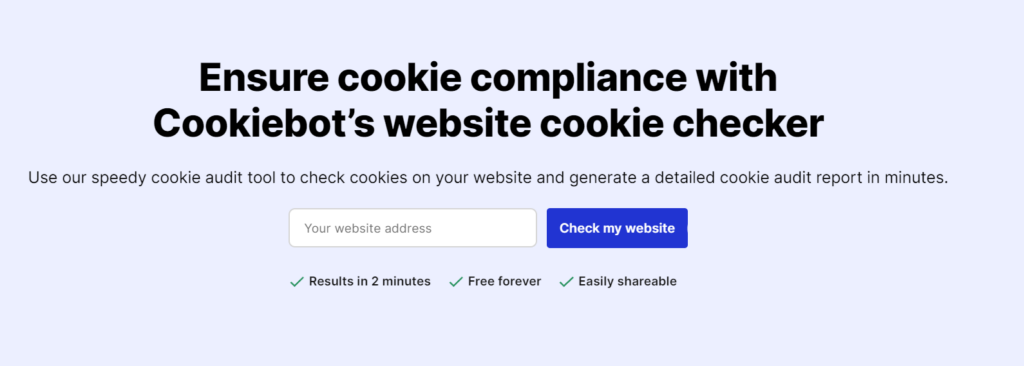
Cookiebot™ offers pre-built templates in addition to customizable consent banners that enable compliance with the GDPR regulation out of the box. There is cookie banner support for nearly 50 languages to provide clear, transparent consent options to users worldwide. Companies can customize fonts, colors, messaging, add their logo, and more to ensure their consent banner is on brand.
Users Love Us.
G2 award earned after collecting 20 reviews with an average rating of 4.0 stars
The platform securely stores consent for 12 months, with consent information logs available for audit purposes or data subject access requests, enabling compliance with the GDPR's data protection and retention requirements.
Note that different laws have different consent renewal and consent retention requirements. Be sure to familiarize yourself with the requirements of all relevant data privacy laws and consult with qualified legal counsel.
Cookiebot™ offers multiple pricing plans tailored to the needs of websites of varying sizes and complexities. There is a free plan for sites with fewer than 50 subpages and paid plans based on website size so you can choose a plan that aligns with your compliance needs and budget. The smallest paid plan is EUR 7 per domain per month. New signups start with a 14-day free trial, so you can explore all the software’s features.
Get peace of mind and effortlessly achieve GDPR compliance using Cookiebot
Usercentrics
Usercentrics is an EU-based company with customers in 180+ countries, offering a comprehensive suite of features to enable GDPR compliance across websites, apps, and connected platforms.
Usercentrics CMP is a Google-certified CMP, enabling compliance with Google’s requirements, like those for its EU user consent policy and using Google Consent Mode v2. This enables your use of Google's services and collection of personal data to adhere to GDPR regulatory requirements.
The CMP also provides numerous integration options with popular marketing tools, workplace apps, and platforms like Google’s tools, HubSpot, and Mailchimp. It can also collect consent contextually for services connected to YouTube, social plugins, Google Maps, and other social platforms — you can automatically add a visual layer on those iframes — to enable GDPR compliance across all your digital touchpoints.
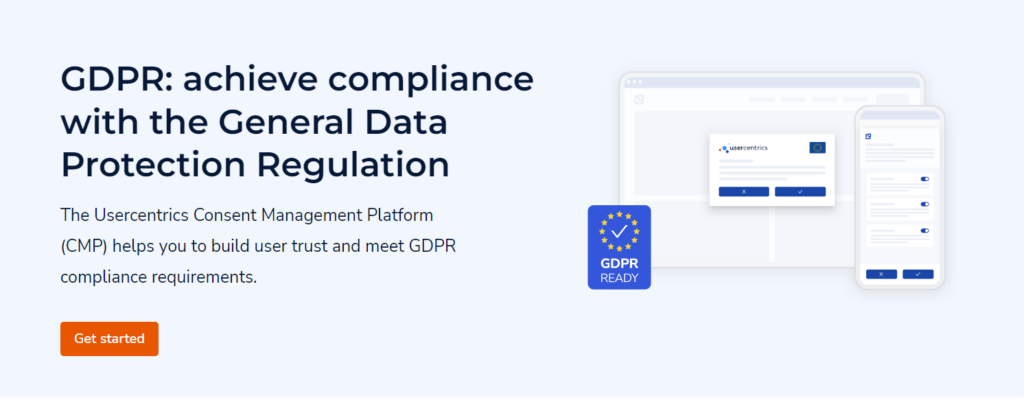
Usercentrics is great for growing and enterprise-level companies that need a reliable, scalable solution with many features. For organizations that have multiple people in charge of — or working with — their website data, Usercentrics offers multiple levels of account and permissions management for security and resource distribution. The extensive database of legal templates also enables administrators to save time and resources.
Usercentrics enables website owners to optimize consent rates through in-depth analytics, A/B testing, full consent banner customization, and more. It also has geotargeting functionality and supports over 60 languages. Easily provide clear, transparent consent options to users worldwide.

Usercentrics paid plans start at EUR 50 per month per domain, and tiers are organized by number of sessions. There is no free plan, but there is a 30-day free trial.
Elevate your privacy strategy and explore Usercentrics enterprise-grade features.
OneTrust
OneTrust provides a well-known consent management solution built for large enterprise companies that have an IT network. The platform helps companies comply with over 25 regulatory bodies, including the GDPR, with features to enhance privacy management, data governance, IT risk and security assurance, and a host of other features.
One feature of OneTrust is its ability to facilitate data mapping, record-keeping, and consent management processes required by the GDPR. The platform enables organizations to create a centralized inventory of data flows, cross-border transfers, processing activities, and consent preferences. It leverages pre-defined templates and automated workflows to maintain an evergreen data map and help ensure compliance reporting is up to date.
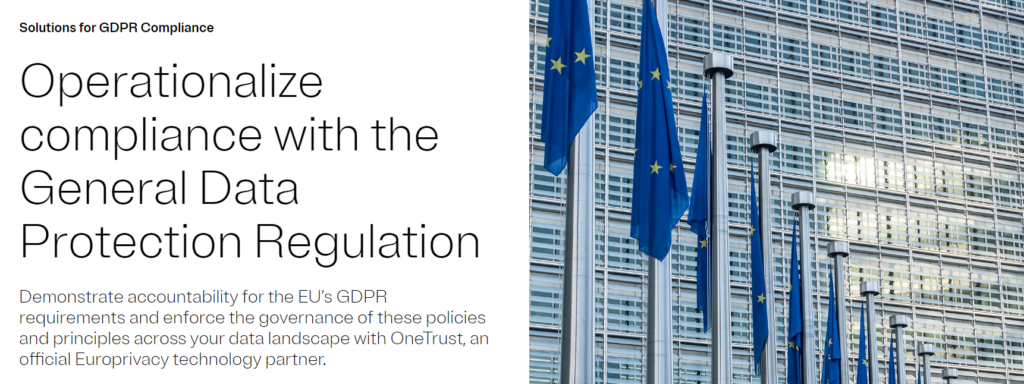
Integrating OneTrust with other systems may be challenging due to its sophisticated set of features, which could contribute to a lengthier implementation process.
OneTrust does not openly disclose its pricing on its website. According to various sources, contract sizes are reported to start at approximately USD 50,000 per year. However, the price varies depending on the number of domains and the modules you wish to use. Contracts tend to be long-lasting, which may limit flexibility for companies.
Enzuzo
Enzuzo is a low-code solution for implementing the key requirements of the GDPR and is designed for websites and apps.
The GDPR compliance platform enables businesses to create customizable cookie consent banners tailored to their brand's look and feel. These banners can be configured to appear in specific regions and languages.
Additionally, Enzuzo provides tools designed to generate legally compliant privacy policies, terms of service agreements, and other legal documents.
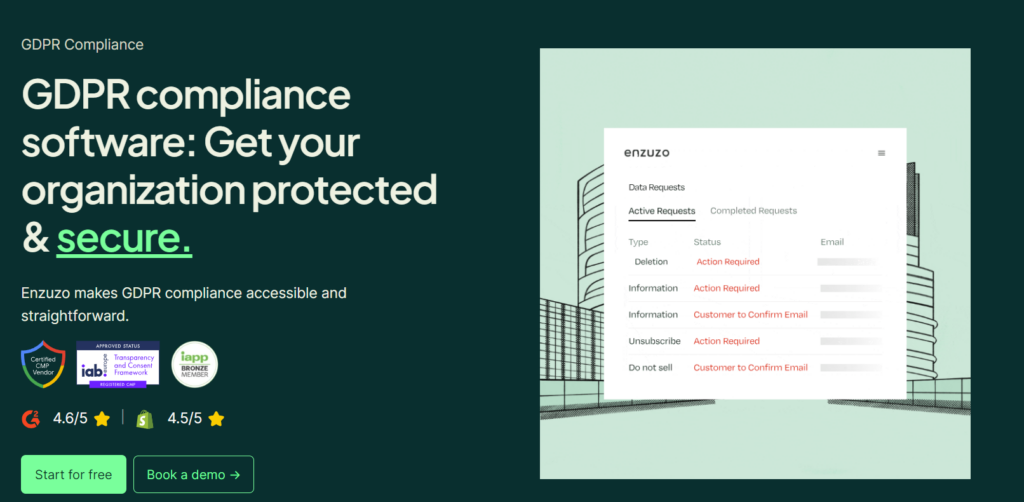
Enzuzo may have potential limitations to consider. The free plan only allows for three data subject access requests per month, which may not be sufficient for businesses with higher volumes of requests.
Enzuzo offers a range of plans to suit different business needs. The free plan includes standard legal policies, a custom cookie banner, and compliance reporting. Paid plans start at USD 9 per month, which unlocks additional features, like custom legal policies, language detection, and analytics. The highest tier, priced at USD 130 per month, applies to 20 domains, offers unlimited users, and provides a dedicated customer success manager.
TrustArc
TrustArc is another GDPR compliance solution that helps enterprise organizations streamline their privacy operations and enables compliance with the GDPR, among other regulations. It offers a comprehensive suite of tools and services designed to simplify the complex task of managing personal data and adhering to privacy laws.
One of the features of TrustArc’s solution is its ability to automate various aspects of the compliance process. The software enables organizations to identify and catalog the personal data they collect, process, and store to maintain a detailed inventory of their data processing activities.
Additionally, TrustArc provides tools for conducting Privacy Impact Assessments to assess the potential risks associated with data processing and implement appropriate safeguards.
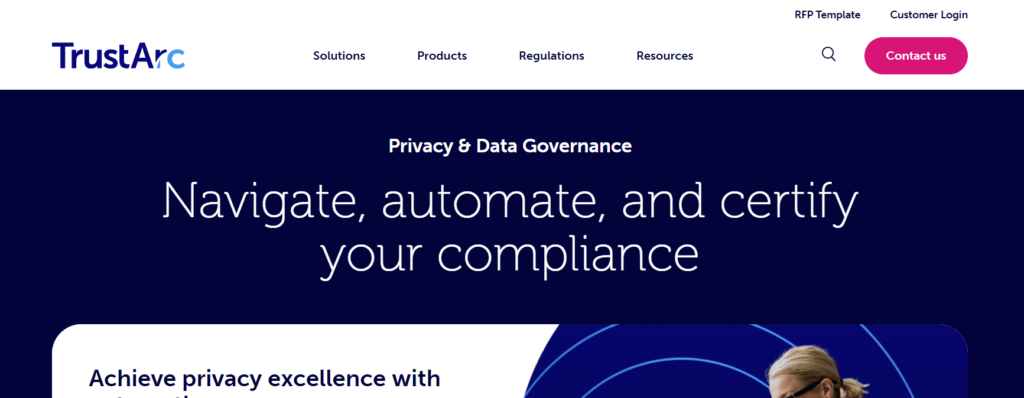
Complex GDPR software such as the solution from TrustArc would benefit from responsive and helpful customer service. However, user reviews have reported problems with this, citing slow response times and difficulties resolving problems.
TrustArc’s website does not offer any pricing information, so you must contact a representative for that information.
Osano
Osano advertises that it has a strong commitment to legal policy management through its platform, and offers a unique "No Fines, No Penalties” Pledge, assuring coverage for fines up to USD 200,000 for GDPR violations for customers using their solution.
Osano also offers a unified consent and preference hub, enabling users to centralize and manage consent and preferences across various channels, such as websites, mobile apps, and offline interactions.
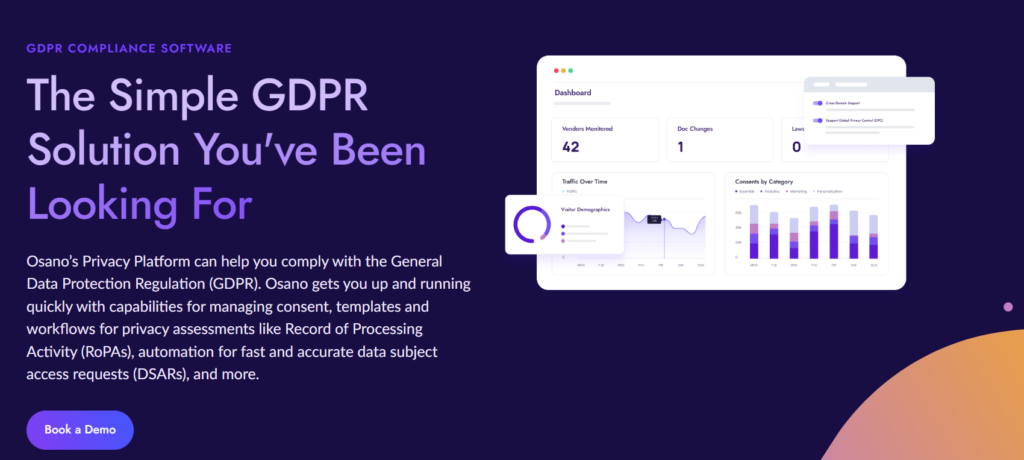
Pricing for Osano’s consent and preference management platform can be higher than for some other solutions, and is based on a company’s website traffic. Their free plan allows for up to 5,000 monthly website visitors, and the next tier Plus plan is up to 30,000 monthly. In addition, Osano offers pre-designed legal templates for implementation rather than fully customizable options, which could impact users seeking tailored solutions.
Osano’s pricing starts at USD 199 per month for its Plus plan. Additionally, only their paid plans include essential GDPR and CCPA compliance features.
iubenda
iubenda offers another GDPR compliance solution with a range of tools to help businesses meet their data privacy obligations. iubenda advertises that it provides a user-friendly platform that integrates various features, including privacy policy generation, cookie consent management, and data processing records management.
iubenda offers a privacy and cookie policy generator, which enables businesses to create customized and legally compliant privacy policies and cookie notices in multiple languages. According to iubenda, these documents are automatically updated to reflect changes in data protection laws, enabling businesses to remain compliant at all times.
Additionally, iubenda offers a privacy controls and cookie solution that enables businesses to display customizable cookie banners, collect user consent, and implement prior cookie blocking to comply with the GDPR and ePrivacy Directive.
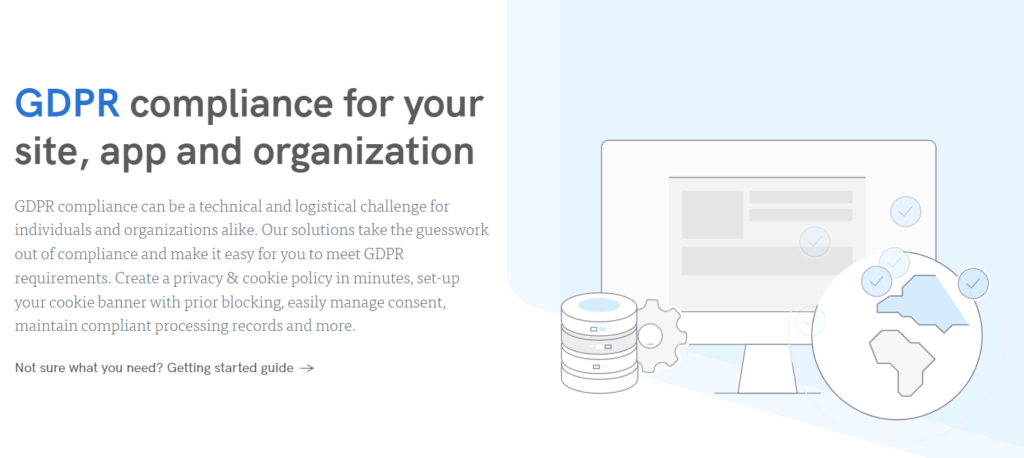
iubenda offers a comprehensive suite of tools and features. However, some user reviews have mentioned how it is a less user-friendly option for those seeking a simpler solution.
In terms of pricing, iubenda offers a range of plans to cater to businesses of different sizes and needs. The free plan provides basic features, while the paid plans (Essentials, Advanced, and Ultimate) offer increasingly more advanced features and support for additional websites or apps. Large organizations can also request tailored pricing based on their specific requirements.
AuditBoard
AuditBoard is a comprehensive data compliance, network auditing, and IT protection digital security platform that helps organizations comply with various regulatory systems, including the GDPR. It offers a range of risk management and operational evaluation systems to ensure data privacy and security. However, unlike other solutions, they don’t offer a CMP to manage user consent for data processing as required by the GDPR.
According to reviews, AuditBoard GDPR software is very good for handling sensitive data securely. It follows best-in-class security protocols and employs encryption techniques to protect personally identifiable information.
Additionally, AuditBoard provides automatic privacy policy updates, enabling organizations to remain compliant with ever-changing data privacy regulations.
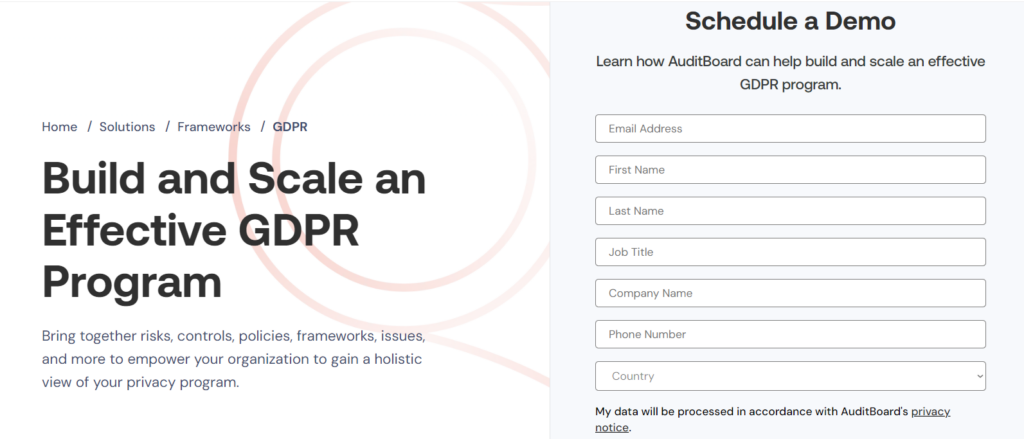
However, according to customer reviews on G2, AuditBoard may not integrate well with some platforms and offers limited customization options once implemented.
In terms of pricing, AuditBoard does not publicly disclose its pricing structure. Contact AuditBoard to receive a tailored quote based on your organization's specific requirements.
CookieScript
CookieScript claims that it is a smaller, lighter, and cheaper data compliance software designed specifically for smaller businesses with fewer domains.
However, it’s still a full compliance solution that offers features such as consent management, data subject requests, and IAB TCF 2.2 support. It integrates with platforms and tools like Google Tag Manager and WordPress.
Like other companies, CookieScript can automatically scan websites for cookies, categorize them, and provide detailed descriptions. This saves website owners from the tedious task of manually identifying and documenting cookies. It also offers the option to block third-party cookies by default until users consent to the website's privacy policy, thus enabling companies to be GDPR-compliant.

CookieScript’s pricing structure is set up and limited by domain bundles — for 2, 5, 10, 20, 50, 100, or 200 domains — which may require companies to pay for more than they need if they fall between these tiers.
CookieScript offers a free plan for one domain with up to 10 scanned pages. Once you select your desired domain bundle, you also select the plan tier: Lite (EUR 8/month), Standard (EUR 15/month), or Plus (EUR 19/month). That pricing is for the smallest domain bundle of two domains. Pricing increases the larger your domain bundle is. All plans require a one-year subscription.
The free plan can be best for small websites needing only a simple cookie consent banner. All GDPR tools are only included in their EUR 19 Plus plan.
Sprinto
Sprinto offers GDPR privacy software that can help automate and streamline the GDPR audit process to comply with the latest privacy and security requirements.
Sprinto offers 24/7 monitoring capabilities to verify adherence to all the GDPR regulations. It monitors employees, devices, servers, contractors, and more. This continuous monitoring mitigates the risk of costly noncompliance penalties.
Additionally, Sprinto streamlines the audit process by providing a console that displays data as an auditor would generally expect, enabling contactless audits and faster certification.
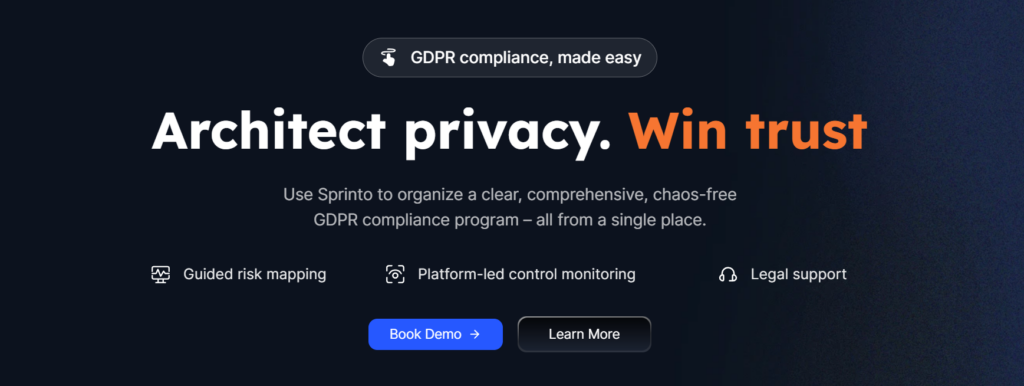
While Sprinto is a powerful GDPR compliance solution, it may not be suitable for companies preferring on-premise software deployments, as it is primarily a cloud-based platform. According to user reviews on G2, there are frequent product updates that, while enabling compliance with the latest regulatory changes, may require users to adapt regularly to new features or interface modifications.
Sprinto does not offer a free trial, and they do not advertise the cost of their platform. You can book a demo and get a custom quote based on your company's needs.
10 of the best GDPR compliance software compared
| Software provider | Pros | Cons | Price |
|---|---|---|---|
| Cookiebot™ | - Google-certified CMP - Simple setup and onboarding flow - Automatically detects and controls all cookies and trackers - Fully customizable cookie banners - Supports nearly 50 languages | - Only for web - Free plan only available for small websites | - Free 14-day trial for all new accounts - Free plan available for 50 subpages or fewer - Premium plan from EUR 7/month per domain |
| Usercentrics | - Google-certified CMP - Intuitive interface with numerous integration options - Extensive analytics dashboard with options for A/B testing - Database of over 2,200 legal templates - Supports over 60 languages - Offers different admin roles - Customer Success Team and good customer support | - No free plan - Initial manual effort in the implementation process - Customer Success Manager only available in the Premium package | - Free 30-day trial available for web and app - Paid plans start at EUR 50/month |
OneTrust | - Offers many additional features for enterprise companies - Very up to date with privacy laws - Many integration options with other business intelligence platforms | - Complex and lengthy implementation process - Most expensive option on the market | - 14-day free trial - No free plan - Pricing varies depending on the number of domains and the modules you need |
Enzuzo | - Create customizable cookie consent banners - Enables automatic generation of legally compliant privacy policies | - Limitations to their free plan that make people feel pressured to upgrade | - Offers a free plan - Paid plans start at USD 9/month and go up to USD 130/month |
| TrustArc | - Offers consent notifications in 45 languages - Robust reporting capabilities - User-friendly interface | - Poor customer service - Unclear pricing | - No pricing information is available |
| Osano | - Strong commitment to legal policy management - Risk-free guarantee - Very customizable cookie consent banners | - Monthly cap on site traffic - Cut-and-paste legal templates that may limit customization | - No free trial - Paid plan starts at USD 199/month |
| iubenda | - One-stop shop for GDPR compliance - Privacy and cookie policy generator | - Not very user-friendly | - Offers free plan - Three-tiered paid plans starting at USD 5.99 and going up to USD 99.99 |
| AuditBoard | - Very powerful when it comes to handling sensitive data - Automatic privacy policy updates | - Limited customization options - Issues with multiple integrations - Does not offer a CMP | - No free trial - No pricing information available |
| CookieScript | - Easy to implement and use - Automatically scans cookies - Customizable cookie banner | - You will need to pay for a higher price point even if you have fewer domains - All GDPR tools are only offered in their paid Plus plan | - Offers a free plan if you need a simple cookie consent banner - Paid plans start at EUR 8/month and go up to EUR 19/month for the smallest domain bundle, but pricing increases with larger domain bundles |
| Sprinto | - 24/7 monitoring capabilities - 100+ integration options - Streamlined audit process | - Not suitable for companies preferring on-premise software deployments - Frequent product updates may require users to adapt regularly to new features or interface modifications | - No free trial - No pricing information available |
How to choose the right GDPR software
To pick the right GDPR compliance tool for your company, you’ll want to look at:
- degree of customization
- integration options
- technical resource requirements
- scalability
- pricing, particularly based monthly, per domain, etc.
- analytics and reporting functionality
If you have a simple website and a limited number of website visitors, simpler GDPR management software is likely the best choice for your resource availability and budget.
However, larger organizations will likely require robust and scalable functionality, multi-regulation and language support, and full customization options. Therefore, an enterprise GDPR privacy management software that offers advanced features, customization options, extensive integrations, and seamless scalability might better suit enterprises seeking to achieve GDPR compliance across many sites and platforms.
If you’re just getting started, develop a thorough understanding of the cookies and other trackers or components collecting personal data on your website. Try Cookiebot’s™ speedy cookie audit tool to check your website and generate a detailed cookie audit report in minutes.
Gain insights into the cookies on your website!Cookiebot™ does not provide legal advice, and information is provided for educational purposes only. We always recommend engaging qualified legal counsel or privacy specialists regarding data privacy and protection issues and operations.
The information presented in this article is accurate based on publicly available sources as of the date of publication. Details about products, features, pricing, etc. may change over time.
FAQ
GDPR compliance software helps organizations implement and maintain compliance with the European Union's General Data Protection Regulation (GDPR). These solutions automate and streamline various data protection governance processes mandated by the GDPR, including obtaining valid consent from users for the collection and processing of personal data.
A Consent Management Platform (CMP) is a software solution that helps websites and apps collect, manage, and record user consent for the processing of personal data, such as that accessed via cookies and tracking technologies. CMPs enable compliance with data privacy regulations like the GDPR by providing consent banners, tracking user preferences, and controlling data collection based on those preferences.
To make your website GDPR-compliant, you need to obtain explicit consent from users before collecting any personal data, and provide clear information about what data you collect, how it is processed, and who has access to it.
To pick the right GDPR compliance software for your company, you’ll want to look at the following and ensure it meets your company’s needs:
- degree of customization
- integration options
- technical resource requirements
- scalability
- pricing, particularly based on monthly, per domain, etc.
- analytics and reporting functionality
Yes, if your website collects or processes personal data from individuals residing in the European Union, you need a GDPR compliance solution to meet the requirements of the regulation and avoid potential fines and penalties.